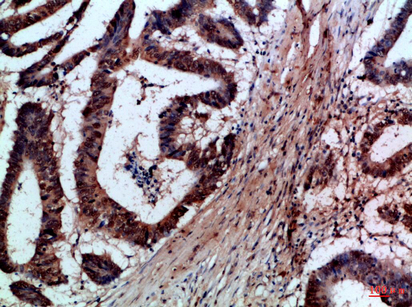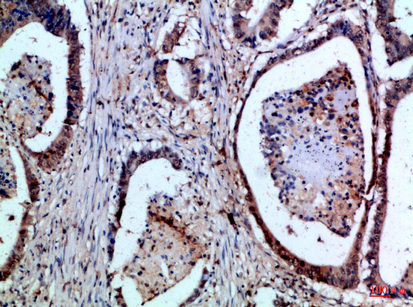FAS-L Polyclonal Antibody
- Catalog No.:YT6037
- Applications:IHC;IF;ELISA
- Reactivity:Human;Rat;Mouse;
- Target:
- FAS-L
- Fields:
- >>Platinum drug resistance;>>MAPK signaling pathway;>>Ras signaling pathway;>>Cytokine-cytokine receptor interaction;>>FoxO signaling pathway;>>PI3K-Akt signaling pathway;>>Apoptosis;>>Necroptosis;>>Natural killer cell mediated cytotoxicity;>>Neurotrophin signaling pathway;>>Non-alcoholic fatty liver disease;>>Alcoholic liver disease;>>Type I diabetes mellitus;>>Pathways of neurodegeneration - multiple diseases;>>Pathogenic Escherichia coli infection;>>Chagas disease;>>African trypanosomiasis;>>Hepatitis C;>>Hepatitis B;>>Measles;>>Human cytomegalovirus infection;>>Influenza A;>>Human papillomavirus infection;>>Herpes simplex virus 1 infection;>>Human immunodeficiency virus 1 infection;>>Pathways in cancer;>>Proteoglycans in cancer;>>Autoimmune thyroid disease;>>Allograft rejection;>>Graft-versus-host disease;>>Lipid and atherosclerosis
- Gene Name:
- FASLG APT1LG1 CD95L FASL TNFSF6
- Protein Name:
- Tumor necrosis factor ligand superfamily member 6 (Apoptosis antigen ligand) (APTL) (CD95 ligand) (CD95-L) (Fas antigen ligand) (Fas ligand) (FasL) (CD antigen CD178) [Cleaved into: Tumor necrosis fac
- Human Gene Id:
- 356
- Human Swiss Prot No:
- P48023
- Mouse Gene Id:
- 14103
- Mouse Swiss Prot No:
- P41047
- Immunogen:
- Synthetic peptide from human protein at AA range: 121-170
- Specificity:
- The antibody detects endogenous FAS-L
- Formulation:
- Liquid in PBS containing 50% glycerol, 0.5% BSA and 0.02% sodium azide.
- Source:
- Polyclonal, Rabbit,IgG
- Dilution:
- IHC 1:50-200, ELISA 1:10000-20000. IF 1:50-200
- Purification:
- The antibody was affinity-purified from rabbit antiserum by affinity-chromatography using epitope-specific immunogen.
- Concentration:
- 1 mg/ml
- Storage Stability:
- -15°C to -25°C/1 year(Do not lower than -25°C)
- Other Name:
- Tumor necrosis factor ligand superfamily member 6 (Apoptosis antigen ligand;APTL;CD95 ligand;CD95-L;Fas antigen ligand;Fas ligand;FasL;CD antigen CD178) [Cleaved into: Tumor necrosis factor ligand superfamily member 6, membrane form;Tumor necrosis factor ligand superfamily member 6, soluble form (Receptor-binding FasL ectodomain;Soluble Fas ligand;sFasL);ADAM10-processed FasL form (APL);FasL intracellular domain (FasL ICD;SPPL2A-processed FasL form;SPA)]
- Background:
- This gene is a member of the tumor necrosis factor superfamily. The primary function of the encoded transmembrane protein is the induction of apoptosis triggered by binding to FAS. The FAS/FASLG signaling pathway is essential for immune system regulation, including activation-induced cell death (AICD) of T cells and cytotoxic T lymphocyte induced cell death. It has also been implicated in the progression of several cancers. Defects in this gene may be related to some cases of systemic lupus erythematosus (SLE). Alternatively spliced transcript variants have been described. [provided by RefSeq, Nov 2014],
- Function:
- disease:Defects in FASLG are the cause of autoimmune lymphoproliferative syndrome type 1B (ALPS1B) [MIM:601859]; also known as Canale-Smith syndrome (CSS). ALPS is a childhood syndrome involving hemolytic anemia and thrombocytopenia with massive lymphadenopathy and splenomegaly.,function:Cytokine that binds to TNFRSF6/FAS, a receptor that transduces the apoptotic signal into cells. May be involved in cytotoxic T-cell mediated apoptosis and in T-cell development. TNFRSF6/FAS-mediated apoptosis may have a role in the induction of peripheral tolerance, in the antigen-stimulated suicide of mature T-cells, or both. Binding to the decoy receptor TNFRSF6B/DcR3 modulates its effects.,online information:FAS-ligand entry,online information:FASLG mutation db,PTM:N-glycosylated.,PTM:The soluble form derives from the membrane form by proteolytic processing.,similarity:Belongs to the tumor necrosis fa
- Subcellular Location:
- Cell membrane ; Single-pass type II membrane protein . Cytoplasmic vesicle lumen . Lysosome lumen . Is internalized into multivesicular bodies of secretory lysosomes after phosphorylation by FGR and monoubiquitination (PubMed:17164290). Colocalizes with the SPPL2A protease at the cell membrane (PubMed:17557115). .; [Tumor necrosis factor ligand superfamily member 6, soluble form]: Secreted . May be released into the extracellular fluid by cleavage from the cell surface. .; [FasL intracellular domain]: Nucleus . The FasL ICD cytoplasmic form is translocated into the nucleus. .
- Expression:
- Blood,Leukocyte,Spleen,
- June 19-2018
- WESTERN IMMUNOBLOTTING PROTOCOL
- June 19-2018
- IMMUNOHISTOCHEMISTRY-PARAFFIN PROTOCOL
- June 19-2018
- IMMUNOFLUORESCENCE PROTOCOL
- September 08-2020
- FLOW-CYTOMEYRT-PROTOCOL
- May 20-2022
- Cell-Based ELISA│解您多样本WB检测之困扰
- July 13-2018
- CELL-BASED-ELISA-PROTOCOL-FOR-ACETYL-PROTEIN
- July 13-2018
- CELL-BASED-ELISA-PROTOCOL-FOR-PHOSPHO-PROTEIN
- July 13-2018
- Antibody-FAQs
- Products Images

- Immunohistochemical analysis of paraffin-embedded Human-colon-cancer, antibody was diluted at 1:100

- Immunohistochemical analysis of paraffin-embedded Human-colon-cancer, antibody was diluted at 1:100



